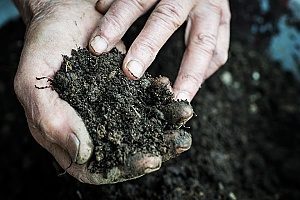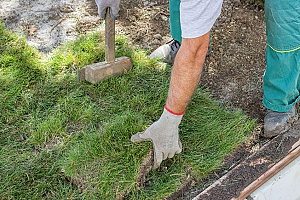 Fill dirt, sometimes called simply “fill”, is dirt that is good for building a stable base for the foundations of building structures and roadways. It has very little to no organic material in it. Fill dirt is usually made of subsoil, which is found about 12 inches below the topsoil. It consists of partially broken down soil made up of a lot of clay, sand, silt, and stones, and any other materials found in the source ground. Its inorganic qualities make it ideal as fill because it is stable.
Fill dirt, sometimes called simply “fill”, is dirt that is good for building a stable base for the foundations of building structures and roadways. It has very little to no organic material in it. Fill dirt is usually made of subsoil, which is found about 12 inches below the topsoil. It consists of partially broken down soil made up of a lot of clay, sand, silt, and stones, and any other materials found in the source ground. Its inorganic qualities make it ideal as fill because it is stable.
Fill dirt is used on new construction sites to level the building site, correct drainage, manage erosion, support building foundations, and install driveways, parking lots, and other structures. It also provides core support for raised garden beds, berms, retaining walls, and outdoor hardscapes.
How to Lay Sod over Fill Dirt
Fill dirt is not suitable for planting materials. It lacks the organic qualities needed to support plants. The lack of organic material means it does not decompose, shift, and settle like organic soil is prone to do. It contains few nutrients beneficial to plant life or organic matter such as insects, worms, and decomposing plant matter. And because it packs tightly, water will not permeate it well. You cannot plant sod or most other landscaping plants directly into the fill dirt and expect the garden to survive. You first have to prepare the surface for plants and sod by amending the soil. Here are the steps you need to take to lay sod over the fill dirt:
1. Remove rocks and debris
Remove as many rocks and other debris from the area to be sodded. You then need to rake the surface to at least an inch deep to remove smaller rocks and break up any clods. A good raking will loosen the soil so that the sod can take root more easily.
2. Level the surface
If the area to be sodded is lumpy or uneven, you should try to level it. Levelling it will help prevent water from pooling and making it harder for the sod to take root in certain areas.
3. Amend the soil
 Before laying the sod, you must amend the soil. You can have it tested to identify what it may be lacking because your fill dirt may consist of just about any type of soil. Testing is not necessary, but it is a good idea. Knowing what is in your soil will help you succeed with your sod along with any other landscaping plants you install later. Your test results will come back within a week or two and tell you exactly what amendments are needed and in what quantity.
Before laying the sod, you must amend the soil. You can have it tested to identify what it may be lacking because your fill dirt may consist of just about any type of soil. Testing is not necessary, but it is a good idea. Knowing what is in your soil will help you succeed with your sod along with any other landscaping plants you install later. Your test results will come back within a week or two and tell you exactly what amendments are needed and in what quantity.
You should rake in amendments to the top layer of fill dirt. If you did not get the soil tested, you can use good quality topsoil, which can be purchased from a garden center or a landscape supplier. Two or three inches of topsoil on top of the fill dirt are ideal. The sod roots will find plenty of nourishment from a good quality layer of topsoil.
Another great amendment for this is compost. Compost will help to balance your soil pH and provide plenty of beneficial micronutrients for plants. It consists of aged organic material, such as kitchen scraps and manure, broken down into a rich loam that will provide food for the sod roots. Compost is easy to find from local farms or purchased at any garden center. Your town compost center may make it available for free. It can be used instead of topsoil or in addition to it. Spread 2 inches of compost. You may also need to add 2 to 3 inches of sand to claylike soil to improve drainage.
4. Water well
Water the entire area 12 to 24 hours before laying sod to provide base moisture.
5. Choose good quality sod
Give your lawn a good start by choosing quality sod. You will do best with sod that is hardy under less than optimal conditions. You want to buy mature sod that has been properly fertilized, with roots that form a dense mat. It needs to be unrolled and planted within 8 to 10 hours of being cut. After that, too much heat builds up in the rolled sod. That heat kills beneficial microorganisms and dehydrates the grass.
6. Lay the sod

Lay the sod tightly against the edges of the adjacent pieces. Stagger the end seams as you would when laying bricks. Fill the seams and gaps with topsoil or compost. Roll it with a water-filled roller to smooth it out and avoid lumps.
7. Water heavily
It should be watered very well immediately after it is laid. Don’t wait until the entire lawn is sodded to begin watering. Water long enough for the water to penetrate about 6 or 7 inches deep. After that, keep the soil consistently moist, but not waterlogged, until the roots have established. Buy a soil probe from a home and garden centers to check moisture levels. After a thorough watering, the soil should be damp at least 3 to 4 inches below the surface. If you did the job right, the water should be draining through the topsoil layer and into the fill dirt.
If you are installing sod on a newly built lawn, be aware that these steps go a little farther than many building contractors and subcontractors typically go. If you can be there to observe their work, you can make sure that they take these few extra steps to ensure a healthy lawn and reduce your burdens later on.
Contact a Virginia Fill Dirt Contractor for More Information
Before you lay your sod, talk to a professional dirt contractor for more information about fill dirt and topsoil. The contractor can visit your site and discuss the kind of dirt you need for your sod-laying project, any special considerations, the quantity of materials, and will schedule your delivery.









































